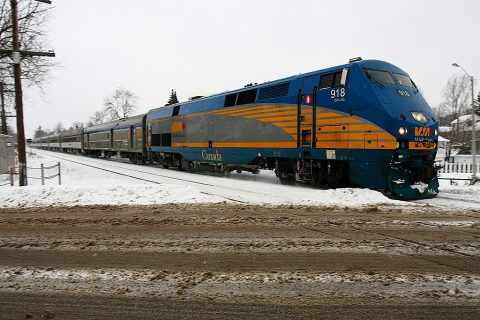Chris Selley outlines the financial black holes that are the two Crown Corporations — Canada Post and VIA Rail Canada:

VIA Rail 918, a General Electric model P42DC locomotive, at Belleville, Ontario on 23 December 2008.
Photo by Martin Cathrae via Wikimedia Commons.
If you’re unfamiliar with Via’s financials, I’ll advise you to sit down now.
In 2023, the average passenger on The Canadian line [Toronto/Montreal to Vancouver] was subsidized by the taxpayer to the tune of $1,014.77. Revenues on the route were less than half of expenses. And your average Canadian can’t even hope to ride the bastard thing: A bunk bed for the 34 hours and 35 minutes it takes to get from Toronto to Winnipeg still goes for the bargain price of $895.
It’s a cruise ship. Not only are we lavishly subsidizing a cruise ship, but we own the cruise line, and we’re buying it new ships. It’s absolutely bananas. And among those applauding the expenditure is, somehow, the NDP’s transport critic Taylor Bachrach. Where’s simplistic populism when you need it? No money for cruise ships!
Meanwhile, media are being far too indulgent of Via’s alarming and increasing vagueness as to whether it’s committed to “high-frequency rail” on the Toronto-to-Quebec City corridor, or to “high-speed rail”, or to some combination of both. This could not be a bigger or brighter red flag: Beware of Oncoming Boondoggle.
Committing billions of dollars to a new rail corridor between Toronto and Quebec City without a firm idea as to whether it’s “high-frequency” or “high-speed” is a bit like committing billions to a new housing development without knowing whether it’s bungalows or high-rise condos. A train going 300 kilometres per hour, or more (i.e., high-speed rail) needs vastly more protection (fences, eliminating level crossings) than a train going 200 kilometres per hour. It’s not a minor detail or something to be worked out later.
And it’s painfully obvious why Via’s executives are sowing the confusion: Because the high-frequency rail plan that they actually have simply isn’t that compelling. It may offer no time savings at all between Montreal and Toronto — and anyone who tries to tell you a five-hour trip between Montreal and Toronto is a compelling option for business people is either a deluded railfan or works for Via.
“Canada charts path for high-speed trains, but obstacles loom,” a recent Globe and Mail headline declared, completely incorrectly. But casual news consumers can absolutely be forgiven for thinking Via’s working on a Toronto-to-Quebec City version of France’s TGV. Should the high-frequency rail plan ever get built, I can only imagine the kvetching and disappointment that would follow.




At least someone can ride your cruise ship trains. Here in California, we are spending well over $100 billion (US) to build a bullet train that is going to go from the southern part of the Central Valley, to the northern part, and back again. Engineering a path through the So-Cal mountains ain’t gonna happen, because it is mostly physically impossible. So the migrant farm workers will be able to ride around the valley to pick the crops (probably on a subsidized ticket), meaning the revenue on the thing will perpetually be $0.
Of course this sort of thing goes on because the reality of California’s processes of government aren’t much different from those of Canada, from what I have been able to observe of each (no thanks to the MS media).
Comment by Dutch — May 31, 2024 @ 19:40
Unless you’re familiar with urban Canadians, you might not realize that the California High Speed Train to Nowhere is still seen as an aspirational goal that Canada should strive to match or exceed. The reality, as you note, is that the money is almost completely wasted and little or no benefit will ever accrue to the taxpayers who’ve funding the boondoggle. Governor Newsom is pouring $x million into the wonderful high speed train program? Canada should double it! Triple it!
Comment by Nicholas — May 31, 2024 @ 22:34